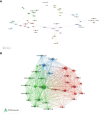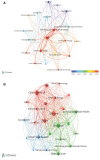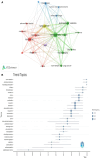Advancements and trends in exosome research in lung cancer from a bibliometric analysis (2004-2023)
- PMID: 38690166
- PMCID: PMC11058220
- DOI: 10.3389/fonc.2024.1358101
Advancements and trends in exosome research in lung cancer from a bibliometric analysis (2004-2023)
Abstract
Background: Lung cancer, characterized by its high morbidity and lethality, necessitates thorough research to enhance our understanding of its pathogenesis and discover novel therapeutic approaches. Recent studies increasingly demonstrate that lung cancer cells can modulate the tumor microenvironment, promoting tumor growth, and metastasis through the release of exosomes. Exosomes are small vesicles secreted by cells and contain a variety of bioactive molecules such as proteins, nucleic acids, and metabolites. This paper presents a comprehensive review of exosome research in lung cancer and its progress through bibliometric analysis.
Methods: Publications related to exosomes in lung cancer patients were systematically searched on the Web of Science Core Collection (WoSCC) database. Bibliometric analysis was performed using VOSviwers, CiteSpace, and the R package "Bibliometrics". Publications were quantitatively analyzed using Microsoft Office Excel 2019. The language of publication was restricted to "English" and the search strategy employed TS=(exosomes or exosomes or exosomes) and TS=(lung cancer). The search period commenced on January 1, 2004, and concluded on November 12, 2023, at noon. The selected literature types included Articles and Reviews.
Results: The study encompassed 1699 papers from 521 journals across 71 countries and 2105 institutions. Analysis revealed a consistent upward trend in lung cancer exosome research over the years, with a notable surge in recent times. This surge indicates a growing interest and depth of inquiry into lung cancer exosomes. Major research institutions in China and the United States, including Nanjing Medical University, Shanghai Jiao Tong University, Chinese Academy Of Sciences, and Utmd Anderson Cancer Center, emerged as crucial research hubs. The annual publication count in this field witnessed a continuous rise, particularly in recent years. Key terms such as lung cancer, non-small cell lung cancer (NSCLC), microvesicles, intercellular communication, exosomal miRNAs, and oncology dominated the research landscape. Fields like cell biology, biochemistry, biotechnology, and oncology exhibited close relation with this research. Clotilde Théry emerged as the most cited author in the field, underlining her significant contributions. These results demonstrate the broad impact of exosome research in lung cancer, with key terms covering not only disease-specific aspects such as lung cancer and NSCLC but also basic biological concepts like microvesicles and intercellular communication. Explorations into exosomal microRNAs and oncology have opened new avenues for lung cancer exosome research. In summary, lung cancer exosome research is poised to continue receiving attention, potentially leading to breakthroughs in treatment and prevention.
Conclusion: Publications on lung cancer exosomes show a rising trend year by year, with China and the United States ranking first and second in terms of the number of publications. However, there is insufficient academic learning cooperation and exchanges between the two sides, and Chinese universities account for a large proportion of research institutions in this field. Jing Li is the most productive author, Clotilde Théry is the most co-cited author, and Cancers is the journal with the highest number of publications. The current focus in the field of lung cancer exosomes is on biomarkers, liquid biopsies, immunotherapy, and tumor microenvironment.
Keywords: CiteSpace; bibliometrics; exosomes; knowledge map; lung cancer.
Copyright © 2024 Zhong, Zhao, Zhang, Xu, Liu, Yang, Jiang and Shen.
Conflict of interest statement
The authors declare that the research was conducted in the absence of any commercial or financial relationships that could be construed as a potential conflict of interest.
Figures












Similar articles
-
Research trends and hotspots of exosomes in respiratory diseases.Medicine (Baltimore). 2023 Sep 29;102(39):e35381. doi: 10.1097/MD.0000000000035381. Medicine (Baltimore). 2023. PMID: 37773786 Free PMC article. Review.
-
A bibliometric analysis of exosomes in sepsis from 2004 to 2022.Medicine (Baltimore). 2023 Aug 4;102(31):e34613. doi: 10.1097/MD.0000000000034613. Medicine (Baltimore). 2023. PMID: 37543762 Free PMC article. Review.
-
Bibliometric analysis of scientific papers on extracellular vesicles in kidney disease published between 1999 and 2022.Front Cell Dev Biol. 2023 Jan 5;10:1070516. doi: 10.3389/fcell.2022.1070516. eCollection 2022. Front Cell Dev Biol. 2023. PMID: 36684427 Free PMC article.
-
Bibliometric and Visualization Analysis of Research on Exosomes as Drug Delivery Systems (2008-2023).Curr Drug Deliv. 2025 Feb 20. doi: 10.2174/0115672018358562250213113042. Online ahead of print. Curr Drug Deliv. 2025. PMID: 39980286
-
Effects of exosomes and inflammatory response on tumor: a bibliometrics study and visualization analysis via CiteSpace and VOSviewer.J Cancer Res Clin Oncol. 2024 Aug 30;150(8):405. doi: 10.1007/s00432-024-05915-y. J Cancer Res Clin Oncol. 2024. PMID: 39210153 Free PMC article.
Cited by
-
Liquid biopsy - a narrative review with an update on current US governmental clinical trials targeting immunotherapy.Future Sci OA. 2025 Dec;11(1):2527598. doi: 10.1080/20565623.2025.2527598. Epub 2025 Aug 7. Future Sci OA. 2025. PMID: 40772765 Free PMC article. Review.
References
Publication types
LinkOut - more resources
Full Text Sources

